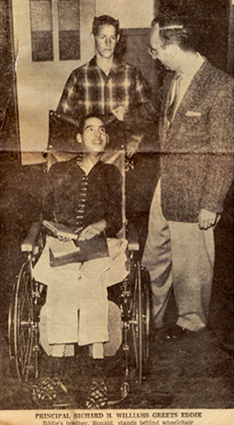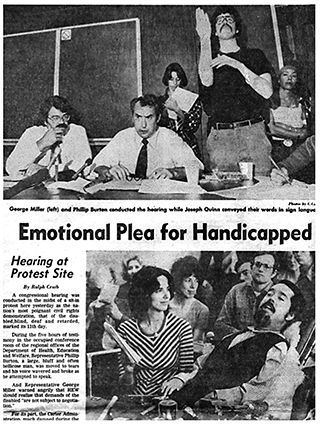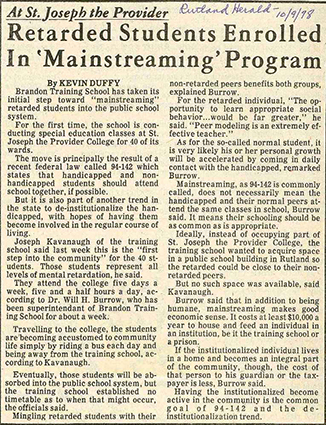
Overview
ctivities in this lesson include individual and group analysis of the changing expectations regarding disability terms and journalistic practices for reporting on disability-related news and topics, examination of stigma and bias reflected in reporting about disability, use of disability-related journalism websites and other websites for research, and opportunities to create news stories, persuasive essays or editorials and creative writing or other creative presentations on the topic of disability in the news.
Civil Rights and Social Change Focus: Responses to disability as represented in the news.
Grade: Grades 9 through 12.
Subject(s): Language Arts/Journalism, Social Studies.
Learning Objectives
- Understand the origins of discriminatory terms and the social and cultural move toward use of respectful language.
- Identify use of respectful language in news stories and incorporate into students’ own discussions and writing on disability.
- Recognize the use of stereotyping in media coverage of disability.
- Recognize and analyze different points of view reflected in media coverage of controversial issues.

Standards
Integration of knowledge and ideas
- Integrate and evaluate content presented in diverse formats and media, including visually and quantitatively, as well as in words.
- Delineate and evaluate the argument and specific claims in a text, including the validity of the reasoning as well as the relevance and sufficiency of the evidence.
- Analyze how two or more texts address similar themes or topics in order to build knowledge or to compare the approaches the authors take.
Time: Four or five class sessions, depending on activities selected.
Setting: Large group discussion with individual or small group research and writing assignments.
Materials
- Flip chart and markers.
- “Words Matter” fact sheet or other press guidelines on disability language and etiquette ( options provided below ).
- Editing Exercise: NCDJ Editing Exercise and Answer Key.
- 1978 mainstreaming article and answer key.
- Disability in the News Worksheet.
- Web journalism sites for research and information are in the Directions section.
- Examples of stories from the news for discussion and possible research and or writing assignments.

Directions
Preparation
Review activities and select the activities and resources to use with your class. Schedule library and computer lab research time as necessary.
Implementation
Introduction: Language Matters ( 40 minutes )
Introduce the lesson and ask students to reflect on their own personal connections with disability and write a brief journal entry about someone they know with a disability or on their own experience with disability. Tell them that we are going to explore media coverage of disability and how the way that disability is presented in the news affects people with and without disabilities. This opening activity looks at the power of words to both shape and reflect past and present attitudes about disability. ( 10 minutes ).
Explain that the purpose of this exercise is to get as many different words or phrases — positive or negative — onto the board or sheets of paper. As a class or in small groups, have students brainstorm words or phrases that were used in the past as well as those used today to describe people with disabilities and disability experiences. To get things rolling, provide some examples on the flip chart or board, using the “Words Matter” fact sheet or other press materials referenced in this lesson to generate some ideas. ( 15 minutes ).
Discuss the terms and phrases that came up: What questions do they raise or what do they tell us about people’s beliefs or attitudes about disabilities and about how individuals with disabilities are perceived? Which words feel oppressive and which empower or feel respectful? From the brainstormed list, create a master list of the OK terms; but tell students that they should be ready to revisit and update this list after completing their Disability in the News research assignments. ( 10 minutes ).
Discuss how the class wants to use the list, i.e., post on wall or type up so everyone has a copy. ( 5 minutes ).
Disability in the News, Part 1 ( 40 minutes )
Have students visit and review selected disability resource websites and materials for journalists. A good one to start with is the National Center on Disability and Journalism, which provides resources for both educators and journalists, including a Style Guide and Resource List and guidelines conducting interviews. Other websites and sources are listed below. ( 10 to 15 minutes ).
N C D J Disability Resource List.
Society of Professional Journalists: Covering Disability Issues.
Ragged Edge, Reporters History of Disability Language.
Ask students to jot down any new language guidelines or ideas on sticky notes and post them on the class “Language Matters” sheet.
Give them one or both of the following assignments to stimulate their analytical skills. ( 25 minutes ).
- Editing Exercise from N C D J: Ask students to read the N C D J exercise and circle examples of disrespectful or inappropriate language. After students have tried the exercise, hand out or review the answer key and ask students to compare the notes from this answer key with their own assessment of the text.
- Looking Back: A disability-related Vermont news story from 1978 is included with this lesson. Have students read and review the article. Ask them to use the Disability in the News Worksheet to record significant content: the news story being covered, words and phrases used to describe individuals with disabilities, alternative language we might use today and their response to the article as they read it today. An answer key is provided to help teachers guide this discussion but students and teachers may also identify additional issues, topics or concerns. Use examples from this article to highlight changing attitudes about disability and language. Words like “handicapped” and “retarded” were once considered appropriate but feel disrespectful or demeaning today.
Disability in the News, Part 2 ( 40 minutes )
In class or outside of class: Assign students to find a recent news article that deals with the topic of disability. Students should use the school’s library, online database, or reliable local and/or national news sources. After selecting their article, students should read it carefully, and use the Disability in the News Worksheet to briefly summarize the article. Students should come to class prepared to discuss the article and answer the questions that follow.
- Why is the story in the media? Identify the focus of the article.
- Is the response to disability positive or negative? Provide examples.
- Are stereotypes present? If so, provide examples. Remember that a stereotype is an extremely general statement about someone or something.
- What is your personal response to the story?
Remind students that they will be sharing their examples and analysis of news articles with classmates.
Discussion and Wrap Up (40 minutes)
Have students share their responses to the articles or media stories they found. This can be done in small groups or with a partner. Ask them to discuss the following: Which articles use respectful language? What articles reflect stereotyping? What feelings, attitudes and expectations about disability are reflected? ( Thirty minutes ).
Create a “Disability Do’s and Dont’s” exhibit that highlights what you have learned about reporting on disability. ( Ten minutes ).

Supplemental Activity
Researching and Writing About Local Issues and Concerns
Getting Started: Start by discussing the stories from “Three Examples of Disability in the News,” which is included with this lesson. Questions from the Disability in the News Worksheet can be used to focus small group or class discussion.
Ask students to imagine that they have been asked to cover one of these three stories for your local or school newspaper. What focus do they want their story or editorial to take? What research do they need to do? Who could they interview? Where else could they go for more information? Ask students to review the guidelines for writing news stories about disabilities and then write a two-page article or commentary on the topic of their choice. Remind students to use respectful language and other press guidelines. Have students present or post their stories for reading and discussion by the class.
Final Project: Have students choose a culminating project addressing significant disability issues and concerns. The National Center for Disability and Journalism provides an index of disability topics, research and interviewing tips, as well as guidelines for writing stories. Great ideas and important topics are also available at the Ragged Edge website or at the Center for an Accessible Society, or any of the resource sites listed in this lesson. Here are some options for a final project:
Research and Write a News Story: Have the student/s research local media or one of the resources sites included with this lesson and pick a topic to research and write about, following the journalism guidelines for researching and writing news stories and covering disability in the news.
Creative Presentations: Have students use poetry, song, theater, a multimedia presentation or other art forms to reflect on a disability issue that is being talked about in their school/community.
Raising awareness with persuasive writing: Individually or in groups, have students select a relevant subject that deals with disability and write an article or editorial suitable for publication in the school or local newspaper. The writing assignment should reflect the language guidelines identified by the class as well as reflect information they have gathered. Ideas for topics can be found on the disability and journalism resource sites included with this lesson.
Resources
General Resources
The American Press Institute’s Disability/Accessibility Resources Page: This website contains information about disability-related topics and guidance on how to cover disability-related news stories.
The Center for an Accessible Society: The purpose of this site is to provide journalists with credible information and quotable sources on national disability policy and independent living issues.
National Disability Rights Network-Disability Etiquette: Reporting and Writing About People with Disabilities and Words Matter (downloaded for Include!).
Disability Scoop is a great website for finding great short articles on topics of concern to people with developmental and other disabilities. Find them at http://www.disabilityscoop.com/.
“Don’t dis me with that language:” This disability language A to Z guide is available on the Internet. Try looking for it on your search engine.
Writers to Know About: Two well known reporters have written disability related books. These are, “Moving Violations: Wheelchairs, War Zones, and Declarations of Independence” by John Hockenberry, and “No Pity” by Joe Shapiro. Both offer great examples of in-depth investigative research and writing ( Shapiro ) and autobiographic writing on being a journalist with a disability ( Hockenberry ). You can also find examples of their reporting online as well as in print.
Websites and Topics to Consider: The Include website includes links to other website and organizations with information on newsworthy topics, including advocacy, disability related abuse and harassment, “Getting Rid of the R Word” campaigns, local accessibility stories, confronting stereotypes, stories of discrimination and of inclusion, and disability rights and social change resources.